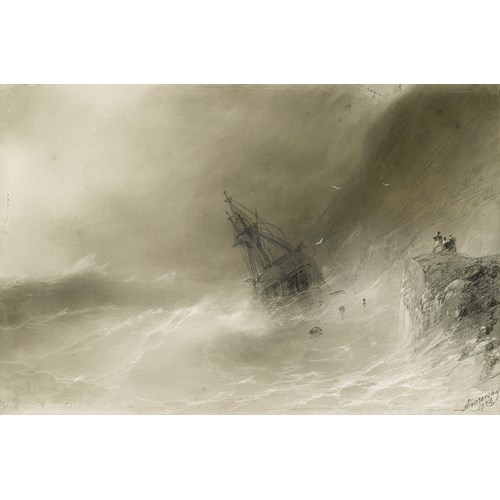Marketplace
An Interior of an Inn with a Peasant Smoking a Pipe and a Soldier Drinking, other Figures Smoking and Drinking in the Background
Joos van Craesbeeck
An Interior of an Inn with a Peasant Smoking a Pipe and a Soldier Drinking, other Figures Smoking and Drinking in the Background
Period 1600-1750, 17th century
Origin Belgium
Medium Oil on panel
Dimension 37 x 46.5 cm (14⁵/₈ x 18¹/₄ inches)
The dark, smoky interior of this inn is alive with social activity. Sitting on the entrance steps, alongside a small terrier who peers inquisitively in through the doorway, a soldier wearing a helmet and breast-plate drinks thirstily from a flagon. Standing over him an older man smokes from a white clay pipe, another tucked into the brim of his brown felt hat. His clothes are tatty and worn suggesting that he is a local peasant. Behind the pair, four figures sit around a table talking, drinking and smoking. Although two figures turn away from the viewer, the sword hanging from the back of one of the men perhaps also identifies him as an off-duty solider.
Despite the darkness of the tavern interior, Joos van Craesbeeck has skilfully introduced aspects of light to the composition. The doorway floods the entrance with a soft, warm light that catches the surface of the seated soldier’s armour. Opposite the open doorway, Craesbeeck has included a side table strewn with objects. The metallic surfaces of a drinking flagon, large serving dish, and bucket stuffed with crustacean legs, all catch the glinting sunlight from outdoors, providing a small still life within the wider scene.
The present work represents an excellent example of Craesbeeck’s early depictions of tavern interiors. Craesbeeck was probably taught by Adriaen Brouwer (1605-1638) and no doubt Brouwer’s scenes of Flemish and Dutch alehouses influenced the subject matter that he subsequently explored. They may have met in 1633 when Brouwer was imprisoned for tax evasion. Craesbeeck, the son of a baker, baked bread for the prison. Initially Craesbeeck focused on depicting tavern interiors filled with simple people, as in the present work, though later he concentrated solely on the middle-classes drinking in the inn and in domestic genre settings. The Drunkard reveals the influence of Brouwer, who often depicted scenes of drunkenness and debauchery in his interiors, and clearly follows this type. In 1633/4, Craesbeeck enrolled in the Guild of St. Luke in Antwerp as a baker and painter and later moved to Brussels where he became a master of the painters’ guild in 1651.
In a letter to the previous owner, dated 16 October, 2007, Dr. Karolien De Clippel confirms the attribution to Craesbeeck on the basis of first-hand inspection. According to her the signature is very characteristic of the artist and fully authentic. She dates the painting to 1636/1637, the period in which Craesbeeck still demonstrates a close relationship with his teacher Adriaen Brouwer. The strong chiaroscuro in this work also fits this date and she compares it to his Quarrel at the Basement of an Inn (Koninklijk Museum voor Schone Kunsten, Antwerp; inventory no. 731).
Despite the darkness of the tavern interior, Joos van Craesbeeck has skilfully introduced aspects of light to the composition. The doorway floods the entrance with a soft, warm light that catches the surface of the seated soldier’s armour. Opposite the open doorway, Craesbeeck has included a side table strewn with objects. The metallic surfaces of a drinking flagon, large serving dish, and bucket stuffed with crustacean legs, all catch the glinting sunlight from outdoors, providing a small still life within the wider scene.
The present work represents an excellent example of Craesbeeck’s early depictions of tavern interiors. Craesbeeck was probably taught by Adriaen Brouwer (1605-1638) and no doubt Brouwer’s scenes of Flemish and Dutch alehouses influenced the subject matter that he subsequently explored. They may have met in 1633 when Brouwer was imprisoned for tax evasion. Craesbeeck, the son of a baker, baked bread for the prison. Initially Craesbeeck focused on depicting tavern interiors filled with simple people, as in the present work, though later he concentrated solely on the middle-classes drinking in the inn and in domestic genre settings. The Drunkard reveals the influence of Brouwer, who often depicted scenes of drunkenness and debauchery in his interiors, and clearly follows this type. In 1633/4, Craesbeeck enrolled in the Guild of St. Luke in Antwerp as a baker and painter and later moved to Brussels where he became a master of the painters’ guild in 1651.
In a letter to the previous owner, dated 16 October, 2007, Dr. Karolien De Clippel confirms the attribution to Craesbeeck on the basis of first-hand inspection. According to her the signature is very characteristic of the artist and fully authentic. She dates the painting to 1636/1637, the period in which Craesbeeck still demonstrates a close relationship with his teacher Adriaen Brouwer. The strong chiaroscuro in this work also fits this date and she compares it to his Quarrel at the Basement of an Inn (Koninklijk Museum voor Schone Kunsten, Antwerp; inventory no. 731).
Period: 1600-1750, 17th century
Origin: Belgium
Medium: Oil on panel
Signature: Signed with initials ‘C B’ (centre right)
Remains of the Antwerp panel maker's mark (on the reverse).
Dimension: 37 x 46.5 cm (14⁵/₈ x 18¹/₄ inches)
More artworks from the Gallery





, in a Green Dress and Pearls, Standing at a Draped _T638990626119457264.jpg?width=500&height=500&mode=pad&scale=both&qlt=90&format=jpg)



